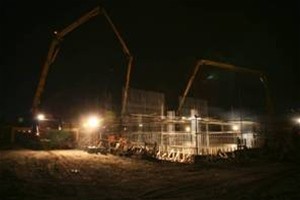Home » Reports & Data » Progress » Transforming Lives » Kabul’s Youth Gain Hope as USAID sets Foundation for New High School

Laborers worked overnight to avoid disrupting daytime school operation.
USAID/Afghanistan
Ghazi High School will provide education for 5,000 students in Kabul City.
27 SEPTEMBER 2008 | KABUL, AFGHANISTAN
In August of 2007, the Ministry of Education achieved a significant milestone by laying the foundation of the new Ghazi Boy’s High School in Kabul, Afghanistan. When completed in late 2009, this $6.25 million school construction project will provide modern classrooms, laboratories, and other learning facilities for over 5,000 students, including the 1,750 students who currently study outside or in temporary shelters. The building is being constructed to the highest seismic safety standards to prevent tragic school collapses like those seen in recent earthquakes in Pakistan and China.
The successful concrete placement was the culmination of months of hard work to design and prepare the building foundation. In order to address very poor soil conditions and a high water table at the site, engineers worked carefully to design a foundation that could support the three-story, 3,500 square meter (40,000 square foot) reinforced concrete structure. The foundation was replaced with specially prepared imported material, and workers installed a strengthening geotextile fabric and used 72 tons of steel to erect a complex web of interwoven bars. Only after laying this strong
foundation could they begin to pour the concrete.
USAID contractor UNOPS and the Ministry of Education agreed to pour the concrete overnight to avoid conflicts with the ongoing school operations and Kabul’s notoriously bad daytime traffic. Laboring through the night, workers placed over 480 cubic meters (628 cubic yards) of reinforced concrete for the 1,200 square meter (13,000 square foot) foundation of the main building. The construction contractor, Mercury Development, employed over 70 concrete mixers and two overhead concrete pumps to provide enough concrete for one continuous pour.
A team of monitoring engineers worked in shifts through the night to ensure the quality and safety of the construction work. As the last load of concrete was poured, all the monitors agreed that the quality of the work met the strict specifications. Most importantly, locally-hired Afghan workers completed over 500 man-hours of night-time work without a single safety incident or injury.
When the school is completed, students will have access to education in a safe and modern environment. To provide girls with similar opportunities, USAID plans to build the Sardar-e-Kabuli girls, which will provide classrooms for 6,000 girls, in November of 2008. New schools such as this empower Afghanistan’s youth with the skills to rebuild their country and give them hope for the future.







Comment
Make a general inquiry or suggest an improvement.